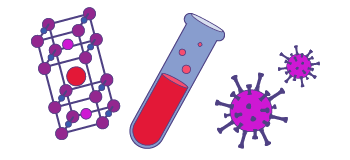Electron transfer dissociation is a popular peptide fragmentation technique in mass spectrometry. It requires multiply-charged gas-phase cations (z>2) and therefore it is typically limited to an electron spray ion source.
The sample, usually in solution, is first ionized by electrospray, and gas-phase "precursor" ions are then captured in an ion trap. ETD fragmentation proceeds in two steps. First, the precursor cation, usually a protein or peptide carrying multiple positive charges, reacts with a pre-ionized anion (e.g., fluoranthene). Capture of an electron from the anion yields an unstable cation radical (Figure 1).

Second, the cation radical then breaks into two fragments, usually one c ion and one z ion (Figure 2). The cleavage is between α-carbon and nitrogen as shown in Figure 3.


The cleavages occur randomly on the protein backbone between any two amino acids (except proline), whereas the side chains can read out a protein amino acid sequence without losing any side chain or chemical modification information.

Explore our magnet schedule to see what exciting research is happening on our stellar fleet of instruments right now.
Y. Mao, et al, Top-Down Structural Analysis of an Intact Monoclonal Antibody by Electron Capture Dissociation-Fourier Transform Ion Cyclotron Resonance-Mass Spectrometry, Analytical Chemistry 85(9), 4239-4246 (2013) Read online.
Y. Mao, et al, Valence Parity to Distinguish c′ and z• Ions from Electron Capture Dissociation/Electron Transfer Dissociation of Peptides: Effects of Isomers, Isobars, and Proteolysis Specificity, Analytical Chemistry 83(20), 8024-8028 (2011) Read online.
H. Ben, et al, Periodic Sequence Distribution of Product Ion Abundances in Electron Capture Dissociation of Amphipathic Peptides and Proteins, Journal of the American Society for Mass Spectrometry 20(6), 1182-1192 (2009) Read online.
Y. Tsybin, et al, Electron Capture Dissociation Implementation Progress in Fourier Transform Ion Cyclotron Resonance Mass Spectrometry, Journal of the American Society for Mass Spectrometry 19(6), 762-771 (2008) Read online.
Y. Tsybin, et al, Ion Activation in Electron Capture Dissociation To Distinguish between N-Terminal and C-Terminal Product Ions, Analytical Chemistry 79(20), 7596–7602 (2007) Read online.
Y. Tsybin, et al, Charge Location Directs Electron Capture Dissociation of Peptide Dications, Journal of the American Society for Mass Spectrometry 17(12), 1704-1711 (2006) Read online.
For more information please contact Lissa Anderson.
Last modified on 08 August 2023